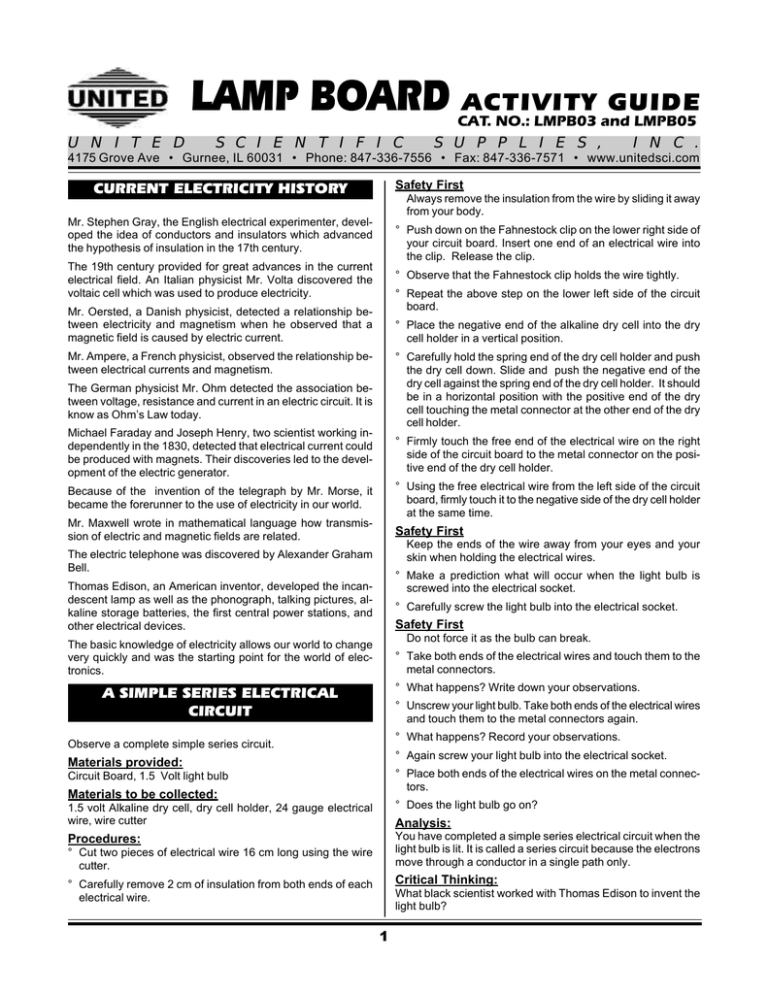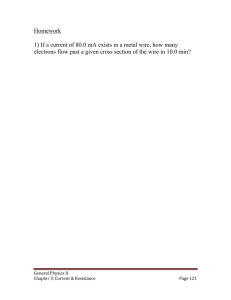View Activity Guide Preview
advertisement

LAMP BOARD ACTIVITY GUIDE U N I T E D S C I E N T I F I C CAT. NO.: LMPB03 and LMPB05 S U P P L I E S , I N C . 4175 Grove Ave • Gurnee, IL 60031 • Phone: 847-336-7556 • Fax: 847-336-7571 • www.unitedsci.com Safety First CURRENT ELECTRICITY HISTORY Mr. Stephen Gray, the English electrical experimenter, developed the idea of conductors and insulators which advanced the hypothesis of insulation in the 17th century. The 19th century provided for great advances in the current electrical field. An Italian physicist Mr. Volta discovered the voltaic cell which was used to produce electricity. Mr. Oersted, a Danish physicist, detected a relationship between electricity and magnetism when he observed that a magnetic field is caused by electric current. Mr. Ampere, a French physicist, observed the relationship between electrical currents and magnetism. The German physicist Mr. Ohm detected the association between voltage, resistance and current in an electric circuit. It is know as Ohm’s Law today. Michael Faraday and Joseph Henry, two scientist working independently in the 1830, detected that electrical current could be produced with magnets. Their discoveries led to the development of the electric generator. Because of the invention of the telegraph by Mr. Morse, it became the forerunner to the use of electricity in our world. Mr. Maxwell wrote in mathematical language how transmission of electric and magnetic fields are related. The electric telephone was discovered by Alexander Graham Bell. Thomas Edison, an American inventor, developed the incandescent lamp as well as the phonograph, talking pictures, alkaline storage batteries, the first central power stations, and other electrical devices. The basic knowledge of electricity allows our world to change very quickly and was the starting point for the world of electronics. Always remove the insulation from the wire by sliding it away from your body. ° Push down on the Fahnestock clip on the lower right side of your circuit board. Insert one end of an electrical wire into the clip. Release the clip. ° Observe that the Fahnestock clip holds the wire tightly. ° Repeat the above step on the lower left side of the circuit board. ° Place the negative end of the alkaline dry cell into the dry cell holder in a vertical position. ° Carefully hold the spring end of the dry cell holder and push the dry cell down. Slide and push the negative end of the dry cell against the spring end of the dry cell holder. It should be in a horizontal position with the positive end of the dry cell touching the metal connector at the other end of the dry cell holder. ° Firmly touch the free end of the electrical wire on the right side of the circuit board to the metal connector on the positive end of the dry cell holder. ° Using the free electrical wire from the left side of the circuit board, firmly touch it to the negative side of the dry cell holder at the same time. Safety First Keep the ends of the wire away from your eyes and your skin when holding the electrical wires. ° Make a prediction what will occur when the light bulb is screwed into the electrical socket. ° Carefully screw the light bulb into the electrical socket. Safety First Do not force it as the bulb can break. ° Take both ends of the electrical wires and touch them to the metal connectors. ° What happens? Write down your observations. A SIMPLE SERIES ELECTRICAL CIRCUIT ° Unscrew your light bulb. Take both ends of the electrical wires and touch them to the metal connectors again. ° What happens? Record your observations. Observe a complete simple series circuit. ° Again screw your light bulb into the electrical socket. Materials provided: ° Place both ends of the electrical wires on the metal connectors. Circuit Board, 1.5 Volt light bulb Materials to be collected: 1.5 volt Alkaline dry cell, dry cell holder, 24 gauge electrical wire, wire cutter Procedures: ° Cut two pieces of electrical wire 16 cm long using the wire cutter. ° Carefully remove 2 cm of insulation from both ends of each electrical wire. ° Does the light bulb go on? Analysis: You have completed a simple series electrical circuit when the light bulb is lit. It is called a series circuit because the electrons move through a conductor in a single path only. Critical Thinking: What black scientist worked with Thomas Edison to invent the light bulb? –1–



